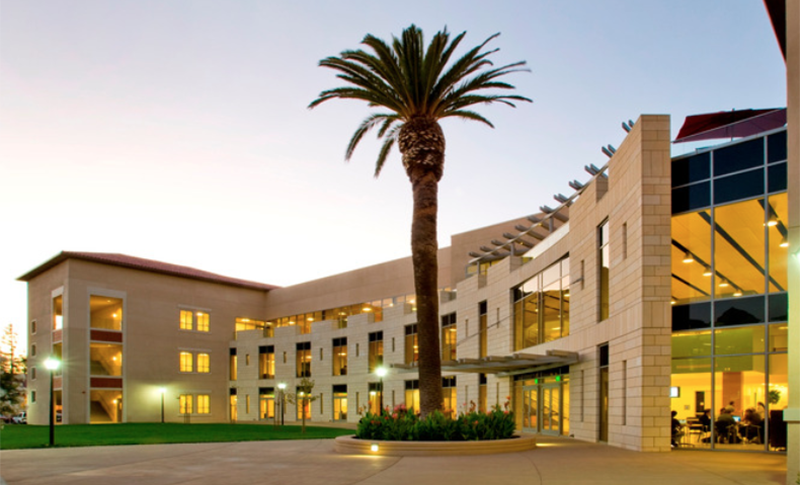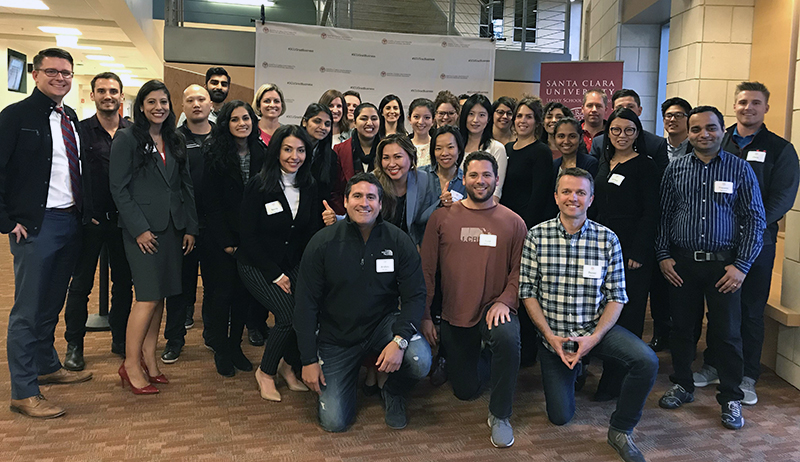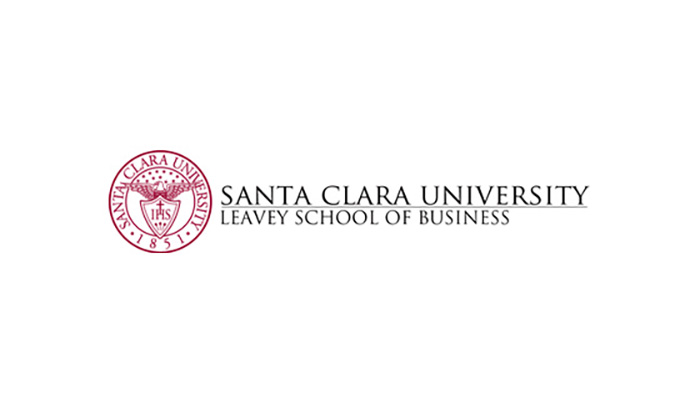Liaison International’s Bob Alig recently interviewed Toby McChesney, senior assistant dean of graduate business programs at Santa Clara University’s Leavey School of Business and chair of Liaison’s BusinessCAS TM advisory board. Toby shares more about his experience launching Santa Clara’s inaugural online program and how the school adapted its marketing efforts to extend its reach.

Bob Alig (BA), Liaison: Santa Clara launched its first online program in January — I know many business schools are working to launch new programs and would love to learn from your experience. Can you tell us more about your marketing efforts to date?
Toby McChesney (TM), Santa Clara University: We had a tight timeline here: we didn’t get to advertise until late October or early November after we got the regional accreditation approval from the Western Association of Schools and Colleges (WASC). Once we got that approval it was full force recruiting for our January 5 start date — we launched with 15 online students, so we had two short months to do that with holidays and whatnot. We moved pretty fast.
This is our first online MBA and it’s my first online program as well, which is exciting. There are so many things we can learn from the experience. First, we wanted a strong tagline for our online MBA. As you know, there are a lot of MBA programs out there, so we had to ask how Santa Clara differentiates itself. We learned there are not many online MBAs in the Bay Area, so we wanted to be the first really strong brand in the area and to expand from there eventually. We came up with the notion that our program helps students disrupt their career. All of our marketing is centered around this message that if you attend our online MBA program, you’ll be able to make big changes or start your own company.
We’ve been targeting students with three or more years of work experience who are serious about continuing their education by getting an MBA from a school in Silicon Valley. We spent a great deal of time optimizing the demographics and did a lot of geo-targeting to help tweak our marketing messaging. We adjusted and optimized our landing pages, ad copy and keywords, depending on the traffic, carefully examining the buzzwords that appealed to our audience.
BA: Beyond your tagline and targeting, can you tell us more about how your approach to recruiting for the new online program is different than outreach for your traditional programs?
TM: For on campus, we didn’t do a lot in terms of mailings — for this campaign we created a special brochure which we mailed to GMAT test-takers in the Bay Area who were looking for an online MBA program. We sent them a mailer in early November which helped us attract attention. We also did more call campaigns. Overall, there was a lot more personal attention paid to every lead we got through our online MBA website.
At Santa Clara, we do not have a full-time MBA program. We have the evening MBA and an Executive MBA, the new online program and three MS programs. Before the online program reared its head, our travel was very limited to California. Now we’re doing more with events in Seattle, Portland and Texas to extend our reach. We can invite alumni in those areas to different events and tell them about our online program — we have something to sell to alums outside the Bay Area and a way to create engagement, which is very powerful.
BA: Tell us about the segmentation work that the Graduate Management Admission Council (GMAC) did a year or so ago and how that impacted your outreach.
TM: I had been at Santa Clara for 13 months, and when I came on board I had to move fast: We redid our evening MBA curriculum that’s identical to the online MBA program, so a lot was going on! Given my past work with GMAC, I thought it was important that Santa Clara did the study. We were one of the pilot schools that jumped in and did the research. We decided to use the tagline, “Our program helps students disrupt their career.” When I look at the data from the students who completed the GMAC survey for the segmentation, the career revitalizers and skill upgraders were the two bigger segmentations we saw. That reflects on-campus students – I want to do the survey again for our online MBA prospects and current students to get a sense of where they’re falling to see if we want to change our marketing message.
BA: Obviously it’s something you’re thinking about going back to, especially as you get a little more perspective on what works and what hasn’t worked.
TM: Absolutely. [For the online program] we anticipate four starts a year, with 20 students per quarter. By fall 2018 we’ll have around 80 online students, so that will be a bigger pool we can survey to find out how we might want to change our marketing message going forward.
BA: Let’s pivot for a couple of minutes to your work over the last few months and your decision to join Liaison’s BusinessCAS advisory board — can you tell me more about that decision? How do you think our work together will serve as a support for you and your peers, especially as you’re thinking about the growth of your online program?

TM: I’ve been blessed to be a part of many different organizations, and I feel it’s really important for any graduate programs leader to work with different organizations. I was on the board with directors in GMAC and have been a part of a number of different organizations as a committee member or on the advisory board for a number of smaller organizations. When I got the call from you, Bob, [inviting me to serve on the board] I was excited but didn’t really know anything about Liaison.
When I first came on board at Santa Clara, I had it in the back of my mind that it would be nice to have a common application; I’ve seen undergraduate programs excelling with that. We had just started using GMAC’s common letter of recommendation and received feedback from employers that having one common recommendation form was helpful. When I got the call, it seemed like a chance to help graduate management education overall. I love Santa Clara and want Santa Clara to thrive, but I think as thought leaders in this space we need to make sure the message is out there to all students that an advanced degree in business is very important. It can help with moving up your career overall or starting your own business — it can deliver a return on investment. I think it’s important to step forward and join these kinds of organizations. I was very happy to do so and got on a plane and flew to Boston for the first BusinessCAS advisory board meeting.
BA: And what were your impressions after that initial meeting?
TM: What really struck me is how large Liaison is — I knew by the website and from phone calls but I don’t think you can really appreciate the scope until you’re on the campus in Watertown. Walking around meeting the people and seeing the operations was really mind-blowing. When I was there, it was the University of California system’s application deadline for undergraduate programs — they had an amazing number of applications and it blew my mind.
It struck me that if we can get more MBA/MS business programs on the BusinessCAS platform, how exciting it will be to extend our reach. We have an opportunity to really help spread the word about the value of a graduate management degree.
I’m always excited to try something new. BusinessCAS is new for Liaison, and it’s exciting for me. Hopefully a few years down the road those of us on the advisory board now will be able to look back and say we were part of the beginning, we helped the platform grow from working with several business schools to supporting several hundred. That’s something I’ve really been touting for our online program – I’ve been interviewing students and telling them, “You’re part of the first ever online program for Santa Clara University.” That’s exciting for them, too — when they graduate in two years, they want to be able to say to their friends and colleagues, “I was part of the first ever online class at Santa Clara.”
You don’t get that option very often, so I think it’s an exciting time. There’s a lot of work to be done to promote BusinessCAS but we’ve already started planting the seeds among various business school folks across the country.
BA: I hadn’t really thought about the parallel between that inaugural MBA class at Santa Clara and the inaugural group with BusinessCAS – that’s terrific. You’ve talked a bit about how you hope BusinessCAS can help expand your outreach and drive engagement with prospective students but are there areas that have surprised you as you’ve gotten to know Liaison and understand BusinessCAS better over the last couple of months?
TM: I did not realize there are over 40 different CAS services you all operate, and I was intrigued by the CAS Summit [an annual meeting of Liaison CAS users that’s taking place during the first annual Liaison User Conference in Boston this July] — I’m hoping to attend that. While I’m focusing on business schools and Santa Clara, it’s powerful to sit down with deans of engineering, schools of medicine, public health and education to talk about overall trends in graduate education.
I think there are parallels — [at Santa Clara] we’re looking at some joint degree programs with the law school, engineering and some other programs as well. I’ve talked to our school dean to find out when someone comes out of a program if they would benefit from specific strategy management courses from the business school. We’re looking at links across disciplines. I see the CAS Summit as an extension of that — a chance to brainstorm and hear what different schools are experiencing. With so much focus on international student enrollments and the political climate, I think it’s important for us to come together and talk through those things and hear about trends.
That’s another thing I enjoy about BusinessCAS: the board members and I can all get together over the phone, through email and at meetings to talk about trends and best practices. I think it’s very powerful.
BA: That’s an interesting overlap. The CAS Summit and the upcoming Liaison User Conference highlight Liaison’s power to convene, and I think that’s what you’re talking about and what you’ve experienced with other organizations.
We’ve learned that as we become more international and develop more diversity of programs, we have to be more creative in how we engage people and how we connect them – not everyone can attend an annual meeting in a different country. Because Liaison has such a vantage point in terms of technology to support and enable education, we can do even more of that in partnership with you and your colleagues.
Getting back to your recent online program launch — is there anything else you’d like to share about that experience?
TM: It was a very heavy lift with our online MBA. We made the strategic decision to have it exactly mirror our revamped evening MBA program. Just when I got to Santa Clara, we were redoing the evening MBA. The numbers were not very strong — the curriculum was not resonating in the marketplace. We made the decision to offer more electives and streamline the program so students could graduate in two years. We built an intensive management strategy class, so students were able to bond on campus at the beginning of the program. We also built in a core data analytics course, which was definitely needed where we are situated in Silicon Valley.
Our enrollment numbers have really skyrocketed since launching the redesigned evening MBA. We virtually doubled our intake without loosening our admissions standards. That’s created a nice buzz at Santa Clara and helped us move into the top 40 in the part-time MBA program rankings in U.S. News & World Report. I think it’s important to highlight that the online program is not a separate animal, it’s tied to our evening program. It has the same admissions process, the same curriculum and the same standards, just some of it is online.
BA: Let’s conclude with some advice: What would you suggest to someone considering launching an online program, or anyone considering something of that nature that requires changing their reach?
TM: Great question. We had an aggressive timeline for a variety of reasons and were really blessed to launch in nine months with 15 students. I would advise anybody looking to do this to talk to someone who’s been there about what resources you need, what companies you can work with and the pros and cons of working with different vendors. We’re a smaller school so we had to go with one; I’m not saying that’s good or bad, it’s what made sense for us. It’s important for leaders to explore both sides before signing a contract with a vendor. Overall, I wanted more time to do research and talk with colleagues about the online MBA space, pros and cons and timelines before jumping into it. It’s a lot of work, but it’s exciting.
Looking for more perspectives from leading GME professionals? Subscribe to our blog so you don’t miss out on any of the interviews in our Trends and Triumphs in Graduate Management Education series.
